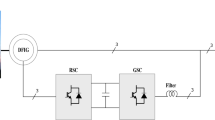Abstract
The problem of controlling doubly fed induction generators (DFIG) associated with wind turbines is addressed. The control objective is twofold: maximum power point tracking and reactive power regulation in the DFIG. Unlike previous works, we seek the achievement of this control objective without resorting to physical sensors of mechanical variables (e.g., wind turbine velocity and DFIG rotor speed). Interestingly, wind velocity is also not assumed to be accessible to measurements. The control problem is dealt with using an output feedback controller designed on the basis of the nonlinear state-space representation of the controlled system. The controller is constituted of a high-gain nonlinear state observer and a nonlinear sliding state feedback mode. Using tools from Lyapunov’s stability, it is formally shown that the closed-loop control system, expressed in terms of the state estimation errors and the output-reference tracking errors, enjoys a semi-global practical stability. Accordingly, it is possible to tune the controller design parameters so that it meets its objectives with an arbitrarily high accuracy, whatever the initial conditions are. These theoretical results are confirmed by simulations involving wide range variation of the wind speed.
























Similar content being viewed by others
References
Akel, F., Ghennam, T., Berkouk, E. M., & Laour, M. (2014). An improved sensorless decoupled power control scheme of grid connected variable speed wind turbine generator. Energy Conversion and Management, 78, 584–594.
Boizot, N., Busvelle, E., & Gauthier, J. P. (2010). An adaptive high-gain observer for nonlinear systems. Automatica, 46(9), 1483–1488.
Dida, A., & Benattous, D. (2015). Modeling and control of DFIG through back-to-back five levels converters based on neuro-fuzzy controller. Journal of Control, Automation and Electrical Systems, 26(5), 506–520.
El Fadili, A., Giri, F., El Magri, A., Lajouad, R., & Chaoui, F. (2013). Adaptive control strategy with flux reference optimization for sensorless induction motors. Control Engineering Practice, 26, 91–106.
Kerrouchea, K., Mezouarb, A., & Belgacema, K. (2013). Decoupled control of doubly fed induction generator by vector control for wind energy conversion system. Energy Procedia, 42, 239–248.
Liao, Y., Li, H., Yao, J., & Zhuang, K. (2011). Operation and control of a grid-connected DFIG-based wind turbine with series grid side converter during network unbalance. Electric Power Systems Research, 81, 228–236.
Maurício, B., Salles, C., Hameyer, K., Cardoso, José R., Grilo, Ahda P., & Rahmann, C. (2010). Crowbar system in doubly fed induction wind generators. Energies, 3, 738–753.
Ouadi, H., Giri, F., De leon-morales, J., & Dugard, L. (2005). High-gain observer design for induction motor with nonlinear magnetic characteristic. IFAC World congress, Prague, Czech July 4–8, Prague.
Patnaik, R. K., & Dash, P. K. (2015). Fast adaptive finite-time terminal sliding mode power control for the rotor side converter of the DFIG based wind energy conversion system. Sustainable Energy, Grids and Networks, 1, 63–84.
Rocha, R. (2011). A sensorless control for a variable speed wind turbine operating at partial load. Renewable Energy, 36, 132–141.
Sarrias-Mena, Raúl, Fernández-Ramírez, L. M., García-Vázquez, C. A., & Jurado, F. (2014). Fuzzy logic based power management strategy of a multi-MW doubly-fed induction generator wind turbine with battery and ultracapacitor. Energy, 70, 561–576.
Slotine, J.-J. E., & Li, W. (1991). Applied nonlinear control. Englewood Cliffs: Prentice Hall.
Suwan, M., Neumann, T., Feltes, C., & Erlich, I. (2012, July). Educational experimental rig for Doubly-Fed Induction Generator based wind turbine. In Power and Energy Society General Meeting, 2012 IEEE, (pp. 1–8).
Utkin, V. I. (1978). Sliding modes and their application in variable structure systems. Moscow: MIR.
Yang, B., Jiang, L., Wang, L., Yao, W., & Wu, Q. (2016). Nonlinear maximum power point tracking control and modal analysis of DFIG based wind turbine. Electrical Power and Energy Systems, 74, 429–436.
Zamanifar, M., Fani, B., Golshan, M. E. H., & Karshenas, H. R. (2014). Dynamic modeling and optimal control of DFIG wind energy systems using DFT and NSGA-II. Electric Power Systems Research, 108, 50–58.
Author information
Authors and Affiliations
Corresponding author
Appendix: Development and Bounding of the Disturbance Terms in (74)
Appendix: Development and Bounding of the Disturbance Terms in (74)
Bounding Term 1:
The first term of (74) satisfies the following inequality
Then with assumptions A1–A3 and remark 2, using (93), inequality (86) can be rewritten as
where
and
Using (29), (66), and using Young’s inequality, (87) can be written as follows:
With
Bounding Term 2:
Using (29), (66), and using Young’s inequality, inequality (96) can be written in the following form:
Bounding Term 3:
introducing (27) in (100), one has:
On the other hand, using Eqs. (22) and (34)–(35) one has:
To avoid that the observer gain \(\theta \) boosts this disturbing term, one can choose the observer design parameter \(K_2 =\frac{1}{\theta ^{2}}\)
Then term 3 becomes:
with
Bounding Term 4:
Using remark 3, (57) and (63)–(64), the four terms of inequality (74) will be discussed separately.
Using (29), (66), inequalities (107–110) can take the form:
where
Rights and permissions
About this article
Cite this article
Barra, A., Ouadi, H., Giri, F. et al. Sensorless Nonlinear Control of Wind Energy Systems with Doubly Fed Induction Generator. J Control Autom Electr Syst 27, 562–578 (2016). https://doi.org/10.1007/s40313-016-0263-1
Received:
Revised:
Accepted:
Published:
Issue Date:
DOI: https://doi.org/10.1007/s40313-016-0263-1




